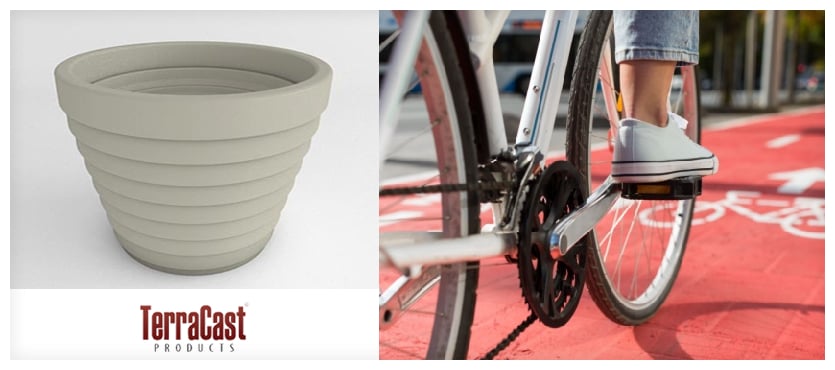As cities continue to prioritize sustainability, bike lanes are becoming more and more optimized. Moving beyond just providing cyclists with thin designated paths, modern bike lane designs are starting to prioritize safety, while also embracing green elements to enhance the aesthetics of our urban environs. One such innovative approach is the incorporation of planters, which serves both of these causes, not only as functional barriers but also bringing natural beauty to otherwise concrete-heavy spaces. Resin planters, in particular, are an ideal choice for these projects, combining durability, aesthetic versatility, and eco-friendliness.
Enhancing Safety with Green Barriers
One of the primary purposes of incorporating planters into bike lane designs is to create a protective barrier between cyclists and vehicular traffic. Some cities have nothing more than a six-inch white line separating you from oncoming traffic; while others might have barriers such as concrete dividers or metal railings, and while effective, often lack visual appeal and can contribute to the sterile feel of urban spaces. Planters, on the other hand, offer a softer, more inviting aesthetic while maintaining the functionality of a protective barrier.
Resin planters are especially well-suited for this application. Their lightweight construction makes them easy to install and reposition, while their durability ensures they can withstand impacts and weather-related wear over time. By using resin planters, cities can create bike lanes that are both safe and visually appealing, encouraging more residents to opt for cycling as a sustainable mode of transportation.
Promoting Environmental Sustainability
Incorporating planters into bike lanes is about more than just aesthetics—it’s also an opportunity to contribute to urban greening initiatives. Planters filled with native plants, pollinator-friendly flowers, or even small shrubs can help improve air quality, reduce urban heat islands, and support local ecosystems. These green spaces can even act as a buffer against noise and pollution, improving the overall experience for cyclists and pedestrians.
Resin planters are an environmentally friendly choice for such projects. Many resin products are made from recyclable or recycled materials, aligning with sustainability goals. Their durability means they won’t need frequent replacements, reducing waste over time. Additionally, resin planters are non-porous, which helps retain water for plants while preventing the material itself from degrading due to moisture.
Flexible and Customizable Design Options
Planters play a dual role in bike lane designs, serving both practical and aesthetic functions. Resin planters, in particular, offer a level of design flexibility that traditional materials like concrete or metal cannot match. They can be molded into various shapes and sizes to suit the specific needs of a project, whether that means creating continuous rows of planters for a uniform look or incorporating unique designs that reflect the character of a neighborhood.
Customizable colors and finishes allow resin planters to blend seamlessly with surrounding architecture or stand out as vibrant focal points. For example, planters can be designed to match a city’s branding or incorporate reflective elements for added visibility during nighttime hours, enhancing both functionality and style.
Cost-Effective and Efficient Installation
One of the challenges of urban development is minimizing disruptions during installation. Materials like concrete or metal barriers often require heavy machinery and extensive labor, leading to longer project timelines and higher costs. Resin planters, by contrast, are lightweight and easy to handle, significantly reducing installation time and effort.
This efficiency makes resin planters a cost-effective solution for bike lane projects, especially in high-traffic urban areas where minimizing disruptions is a priority. Their modular design also allows for easy reconfiguration or relocation if the layout of a bike lane needs to be adjusted in the future.
Creating Inviting Urban Spaces
The addition of greenery to bike lanes can transform utilitarian infrastructure into vibrant, inviting spaces. Planters filled with lush plants soften the urban landscape, making bike lanes more attractive not only for cyclists but also for pedestrians and nearby residents. These green elements can enhance the overall livability of a city, encouraging more outdoor activity and fostering a sense of community.
Planters can also serve as multi-functional elements in urban spaces. For example, they can be integrated with seating or lighting features, further enhancing their utility and appeal. Resin planters’ durability and weather resistance make them an ideal choice for these creative applications, ensuring that they remain functional and attractive over time.
The Future of Green Bike Lanes
Incorporating planters into bike lane designs represents a forward-thinking approach to urban development, combining safety, sustainability, and aesthetics. TerraCast® resin planters can provide an ideal solution for creating bike lanes that not only enhance safety but also beautify the urban landscape. Their lightweight yet resilient design ensures seamless integration into any bike lane project, supporting city planners in building greener, more inclusive streetscapes.
To discover how TerraCast® resin planters can transform your bike lane designs and urban spaces, contact us here for more information.

